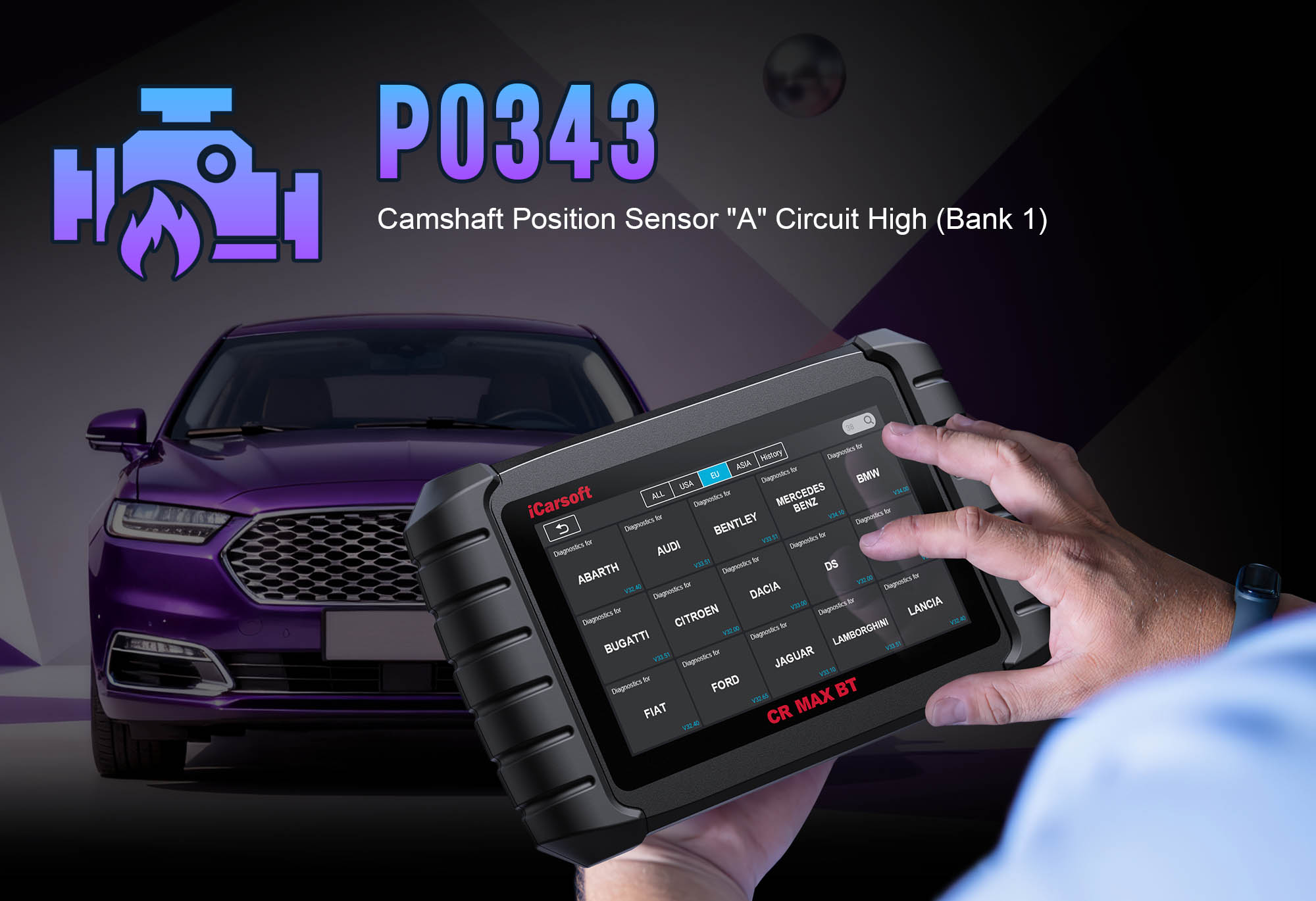Diagnose & Clear P2279 with iCarsoft CR MAX BT
If your vehicle’s check engine light illuminates, you notice rough idling, or it struggles with acceleration, a diagnostic scan will likely return P2279. This OBD-II code stands for "Intake Air System Leak - Bank 1"—a fault indicating an unregulated air leak in the intake system for Bank 1 (the cylinder bank containing the first cylinder in the firing order). The Engine Control Module (ECM) relies on precise air-fuel ratio measurements (via oxygen sensors and mass airflow sensors) to adjust fuel delivery; when unmetered air enters the intake after the mass airflow (MAF) sensor or before the cylinders in Bank 1, it creates a lean mixture (too much air, too little fuel), disrupting combustion and triggering P2279.
Basic scanners might only confirm an "intake leak" but can’t isolate Bank 1, pinpoint leak locations, or verify air-fuel balance—leaving you guessing between a cracked hose, loose clamp, or faulty PCV valve. The iCarsoft CR MAX BT, with its specialized intake system diagnostics, real-time fuel trim tracking, and smoke test integration, solves this. Let’s break down how to diagnose and resolve P2279 with precision, using the CR MAX BT’s unique features to seal leaks and restore engine performance.
Understanding P2279: Causes & Key Symptoms
The intake system delivers filtered air to the engine, with the MAF sensor (or manifold absolute pressure, MAP, sensor) measuring airflow to inform fuel adjustments. A leak in Bank 1’s intake path—after the MAF/MAP sensor but before the cylinders—allows extra unmeasured air into the combustion chamber. This upsets the ideal 14.7:1 air-fuel ratio, forcing the ECM to add more fuel (via positive fuel trim adjustments) to compensate. P2279 triggers when the ECM detects persistent lean conditions in Bank 1, often with long-term fuel trim (LTFT) exceeding +10%. As the fault persists, symptoms worsen:
Key Symptoms of P2279
-
Check Engine Light (CEL): A steady CEL illuminates, often paired with a "Bank 1 Intake Leak" or "Lean Condition" message on the dashboard.
-
Rough Idle: The engine shakes or fluctuates between 500–1,000 RPM as the lean mixture disrupts smooth combustion.
-
Poor Acceleration: Hesitation or "flat spots" when pressing the accelerator, especially at low speeds.
-
Increased Emissions: Unburned oxygen in the exhaust fails emissions tests and may damage the catalytic converter over time.
-
Fuel Efficiency Loss: The ECM’s attempts to enrich the mixture (to counteract the leak) increase fuel consumption by 10–15%.
Common Causes of P2279
|
Cause
|
Description
|
|
Cracked/Damaged Intake Hoses
|
Brittle rubber hoses (between the air filter box and throttle body) develop cracks from heat or age, especially near clamps.
|
|
Loose/Leaking Clamps
|
Intake hose clamps (often worm-gear style) loosen over time, creating gaps where air seeps in.
|
|
Faulty PCV System
|
A cracked PCV hose or stuck-open valve allows excess crankcase air into Bank 1’s intake, acting as an unmetered leak.
|
|
Leaking Intake Manifold Gasket
|
A worn or damaged gasket between the intake manifold and cylinder head for Bank 1 lets air leak into the combustion chamber.
|
|
Throttle Body Gasket Leak
|
A deteriorated gasket between the throttle body and intake manifold creates a path for unmeasured air.
|
|
Loose MAF Sensor Housing
|
A poorly sealed MAF sensor housing (where it connects to the intake hose) allows air to bypass the sensor.
|
Why iCarsoft CR MAX BT Excels at Diagnosing P2279
The CR MAX BT outperforms basic tools with features tailored to intake system and fuel trim diagnostics—critical for resolving P2279 accurately:
Wireless Bluetooth Connectivity
Inspect Bank 1’s intake components from up to 30 feet away while monitoring live data—no tangled cords hinder under-hood access.
Bank-Specific Fuel Trim Tracking
Monitors real-time STFT/LTFT for Bank 1, instantly flagging lean conditions (LTFT > +10%) that confirm an intake leak.
Airflow & Pressure Data
Tracks MAF readings, intake manifold pressure, and O2 sensor voltage to pinpoint where unmetered air enters the system.
AutoVIN Identify
Automatically detects Bank 1 layout, intake system design, and fuel trim thresholds—eliminating manual engine diagram lookup.
Global Vehicle Coverage
Works with 58+ makes (Mercedes-Benz, BMW, Ford, Toyota, etc.) for gasoline and turbocharged engines—OBD-II/OBD-I compatible.
Smoke Test Integration
Guides smoke machine connection via "Intake Leak Test" feature, highlighting invisible leaks.
Component Location Guides
Pinpoints Bank 1 intake parts (hoses, gaskets, PCV valves) with diagrams, reducing search time for leak points.
Step-by-Step: Diagnose P2279 with iCarsoft CR MAX BT
-
Safety First & Initial Visual Inspection
1. Let the engine cool (1–2 hours after driving) to avoid burns from hot components.
2. Locate Bank 1 intake parts via Component Location > Engine > Intake System > Bank 1 (intake hoses, PCV system, gaskets).
3. Check for obvious leaks:
- Tug hoses for looseness; inspect clamps for corrosion/slack (tighten if needed).
- Look for cracks in rubber hoses and oil residue (sign of leaking PCV system).
-
Connect Tool & Confirm P2279
Plug CR MAX BT into OBD-II port, select AutoVIN Identify to retrieve specs. Navigate to Engine > Fault Codes > Read Codes to confirm P2279. Tap Code Details for vehicle-specific insights (e.g., "Toyota Camry: Bank 1 Intake Leak; LTFT: +18%"). Check related codes (P0171, P2270) and resolve P2279 first.
-
Monitor Live Fuel Trim & Airflow Data
1. Start engine, warm to operating temperature (10–15 minutes).
2. Navigate to Engine > Live Data > Fuel Trim & Airflow; monitor Bank 1 metrics:
- LTFT: Normal = -10% to +10%; P2279 shows > +10%.
- MAF Readings: Idle = 2–5 g/s (erratic spikes indicate leaks).
- O2 Sensor Voltage: Steady <0.3V confirms lean mixture.
3. Block suspect leak points with your hand—LTFT dropping to normal = found leak.
-
Perform Advanced Leak Detection
1. Smoke Test Guidance: Use Special Functions > Engine > Intake System Test > Smoke Test Setup—block intake, connect smoke machine, pressurize to 5–10 psi.
2. Manifold Pressure Test: Monitor Live Data > Intake Manifold Pressure—lower than specs = leak.
3. PCV System Check: Pinch PCV hose while monitoring LTFT—improvement = faulty PCV valve/hose.
-
Repair the Leak & Restore Intake Integrity
- Hose/Clamp Repairs: Replace cracked hoses with OEM-spec parts; use stainless steel clamps (torque 20–30 in-lbs).
- Gasket Replacement: Remove old intake manifold/throttle body gaskets, install new OEM gaskets; torque bolts to 18–25 ft-lbs (crisscross pattern).
- PCV System Repair: Replace cracked hoses and non-rattling PCV valves (use OEM parts for proper vacuum regulation).
-
Clear P2279 & Validate the Repair
1. Clear Code: Navigate to Engine > Fault Codes > Clear Codes—confirm P2279 deletion.
2. Post-Repair Check: Verify Bank 1 LTFT returns to -10% to +10% and O2 sensor voltage fluctuates normally.
3. Test Drive: Operate for 30–40 minutes (idle, acceleration, highway speeds) to confirm no issues.
4. Save Report: Document leak location, repairs, and post-repair data via History & Report.
Preventing P2279 Recurrence
-
Regular Intake Inspections: Use Service Reminder to check hoses/clamps/PCV components every 15,000 miles.
-
Fuel Trim Monitoring: Test Bank 1 LTFT monthly via Live Data—rise above +5% indicates developing leaks.
-
Hose Maintenance: Treat rubber intake hoses with UV protectant every 6 months to prevent brittleness.
-
Lifetime Free Updates: Use One-Key Upgrade to add new intake diagnostic features.
Conclusion
P2279’s Bank 1 intake leak isn’t just a performance issue—it risks catalytic converter damage and failed emissions tests. The iCarsoft CR MAX BT simplifies diagnosis with wireless convenience, live fuel trim tracking, and leak detection guidance, ensuring you seal the exact leak point (whether a hose, gasket, or PCV component) instead of guessing.
With its global vehicle coverage, 40+ service functions, and lifetime updates, the CR MAX BT is more than a P2279 fix—it’s a long-term investment in keeping your intake system airtight and engine efficient. Restore smooth idling, boost acceleration, and save fuel—all with one professional-grade diagnostic tool.





